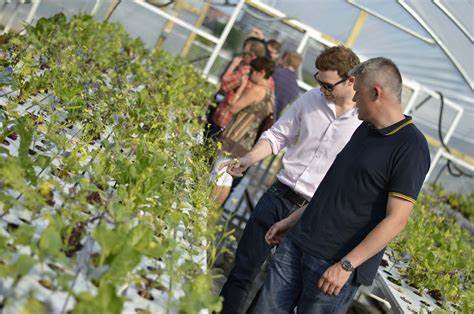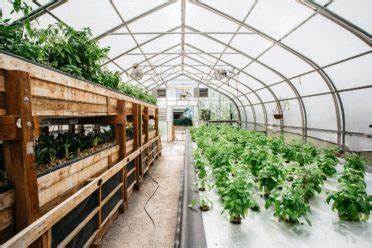
Vertical Farming: Revolutionizing Food Security for a Sustainable Future
Introduction
Vertical farming has emerged as a crucial solution in ensuring global food security. With a growing population and increasing urbanization, traditional agricultural methods are facing challenges in meeting the demand for fresh, nutritious produce. This article explores the historical background, key concepts, and main discussion points surrounding vertical farming. By examining its environmental benefits, increased crop yield and efficiency, and urban food production and accessibility, we can understand the potential of vertical farming in addressing food security concerns.
Historical Background
The concept of vertical farming can be traced back to the early 20th century, with the advent of greenhouses and hydroponics. However, it was not until the 1990s that the term “vertical farming” was coined by Dr. Dickson Despommier, a professor of environmental health sciences at Columbia University. Since then, vertical farming has evolved significantly, incorporating advancements in technology and sustainable practices.
Key Concepts and Definitions
Vertical farming refers to the cultivation of crops in vertically stacked layers, often indoors or in controlled environments. This innovative approach maximizes space utilization and reduces reliance on traditional farming methods. Food security, on the other hand, encompasses both physical and economic access to sufficient, safe, and nutritious food. Key terms related to vertical farming include hydroponics, which is the cultivation of plants in nutrient-rich water, and aeroponics, which involves growing plants in an air or mist environment without the use of soil.

Main Discussion Points
Environmental Benefits of Vertical Farming
One of the main advantages of vertical farming is its potential to reduce land and water usage. By utilizing vertical space, crops can be grown in multilayered systems, requiring significantly less land compared to traditional farming. Additionally, vertical farming minimizes water consumption through innovative irrigation techniques, such as recirculating nutrient solutions. This efficient use of resources contributes to the conservation of water, a critical factor in regions facing water scarcity.
Moreover, vertical farming allows for decreased reliance on pesticides and fertilizers. By cultivating plants in a controlled environment, the need for chemical interventions can be significantly reduced. Integrated pest management techniques, such as the introduction of beneficial insects, can be employed to control pests naturally. Furthermore, the ability to closely monitor nutrient levels eliminates the excessive use of fertilizers, preventing water pollution and soil degradation.
Another environmental benefit of vertical farming is its potential to mitigate climate change impacts. By reducing the reliance on long-distance transportation of produce, vertical farms can significantly decrease greenhouse gas emissions. Additionally, the controlled environment enables year-round production, eliminating the seasonality of traditional farming and reducing the need for energy-intensive food preservation techniques.
Increased Crop Yield and Efficiency
Vertical farming offers the potential for increased crop yield and efficiency through innovative cultivation techniques. By utilizing vertical space and stacking crops, vertical farms can maximize the productivity of limited land. This vertical arrangement also allows for better light exposure, resulting in enhanced photosynthesis and faster plant growth.
Furthermore, vertical farming enables year-round production, irrespective of seasonal variations. The controlled environment provides optimal conditions for plant growth, allowing for continuous harvests and reduced dependence on weather patterns. This not only ensures a stable supply of fresh produce but also reduces the vulnerability of crops to extreme weather events, such as droughts and floods.
Additionally, vertical farming optimizes resources and energy efficiency. With precise control over lighting, temperature, and humidity, resources can be utilized more efficiently, resulting in higher crop yields. The integration of energy-efficient technologies, such as LED lighting and advanced irrigation systems, further reduces energy consumption and promotes sustainability.
Urban Food Production and Accessibility
Vertical farming holds immense potential for addressing food deserts and urban food insecurity. Food deserts are areas with limited access to affordable and nutritious food, often found in urban environments. By establishing vertical farms within or near these communities, fresh produce can be made readily available, improving food accessibility and public health outcomes.

Furthermore, vertical farming reduces the reliance on long supply chains and decreases transportation costs. By producing food locally, vertical farms minimize the distance between production and consumption, resulting in fresher produce with reduced carbon emissions associated with transportation. This localized approach also promotes community engagement and empowers urban residents to actively participate in food production and sustainability initiatives.
Case Studies or Examples
Various vertical farming projects have emerged worldwide, showcasing the potential of this innovative approach. AeroFarms, located in Newark, New Jersey, is one such example. By utilizing vertical stacking and aeroponic systems, AeroFarms has achieved impressive crop yields while minimizing resource consumption. Similarly, Plenty, based in San Francisco, has developed vertical farms that utilize artificial intelligence and robotic systems to optimize plant growth and maximize space utilization. These success stories demonstrate the viability and scalability of vertical farming in different regions.
Current Trends or Developments
Advancements in vertical farming technologies continue to shape the future of sustainable agriculture. The integration of artificial intelligence and automation allows for precise monitoring and control of environmental parameters. Machine learning algorithms analyze data to optimize growing conditions and detect early signs of plant diseases or nutrient deficiencies, ensuring healthier crops and higher yields.
Furthermore, commercial vertical farming operations are scaling up, benefiting from economies of scale and increased demand for locally produced food. This growth is driven by a combination of factors, including advancements in technology, increased consumer awareness of sustainability, and the potential for job creation in urban areas.
Challenges or Controversies
While vertical farming offers numerous benefits, it also faces challenges and controversies. One concern is the energy consumption and environmental footprint associated with indoor farming. The use of artificial lighting, heating, and cooling systems can result in significant energy usage. However, advancements in energy-efficient technologies, such as LED lighting and renewable energy sources, are mitigating these concerns.
Economic viability and profitability are also areas of debate. Vertical farming requires substantial initial investments in infrastructure, technology, and skilled labor. However, as the industry matures and economies of scale are realized, the cost of production is expected to decrease, making vertical farming more economically viable.

Regulatory frameworks and food safety concerns pose additional challenges. As vertical farming is a relatively new industry, regulatory bodies are still developing guidelines and standards to ensure food safety and quality. Stakeholders in the vertical farming sector are actively engaged in addressing these concerns and collaborating with regulatory authorities to establish robust frameworks.
Future Outlook
Vertical farming has the potential to revolutionize global food security. By maximizing space utilization, reducing resource consumption, and producing food locally, vertical farming can play a significant role in feeding the growing population sustainably. Integration of vertical farming into urban planning and sustainable development can create resilient, self-sufficient communities that prioritize food security and environmental stewardship. Furthermore, the exploration of new crops and innovative growing techniques holds promise for diversifying and expanding vertical farming capabilities.
Conclusion
Vertical farming is a transformative approach that addresses the pressing issue of food security. By harnessing innovative technologies, optimizing resource utilization, and promoting local food production, vertical farming offers a sustainable solution to feeding the world’s population. From environmental benefits to increased crop yield and urban food production, this article has explored the various facets of vertical farming. It is clear that vertical farming has the potential to reshape our food systems and pave the way for a more secure and sustainable future.
References
Despommier, D. (2010). The vertical farm: feeding the world in the 21st century. Macmillan.
Ghosal, D., Kumar, A., & Reddy, V. R. (2018). Vertical farming: a sustainable solution for urban agriculture. Frontiers in Agronomy, 1, 5.
Lowry, C. (2020). Vertical Farming: The Future of Sustainable Agriculture? The Yale Review of International Studies, 1(2), 76-93.
Urban, L., & Gourlet, B. (2021). Vertical farming: A review of recent advances and perspectives. Agronomy, 11(2), 222.




